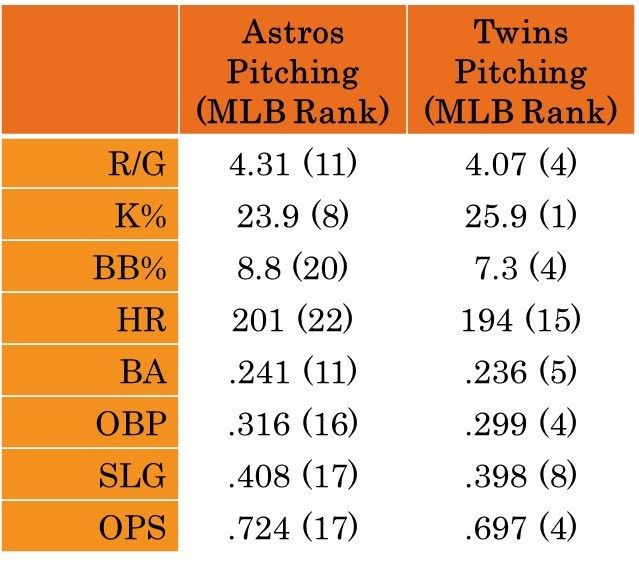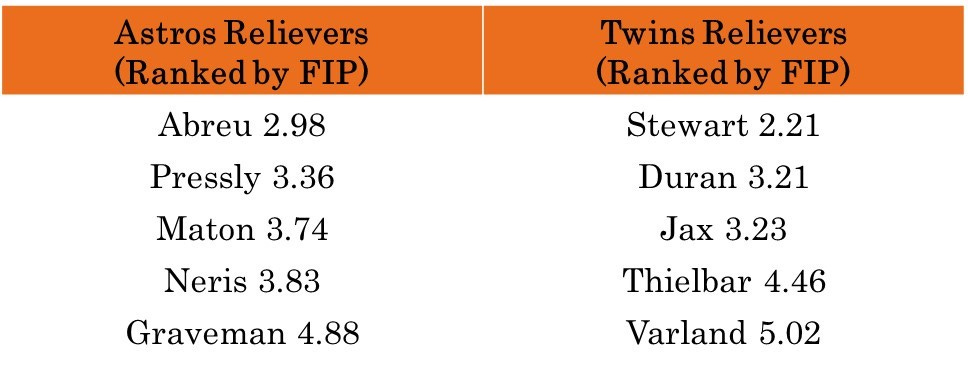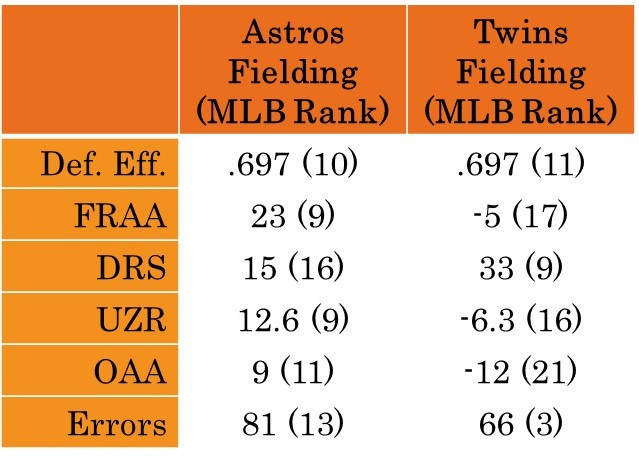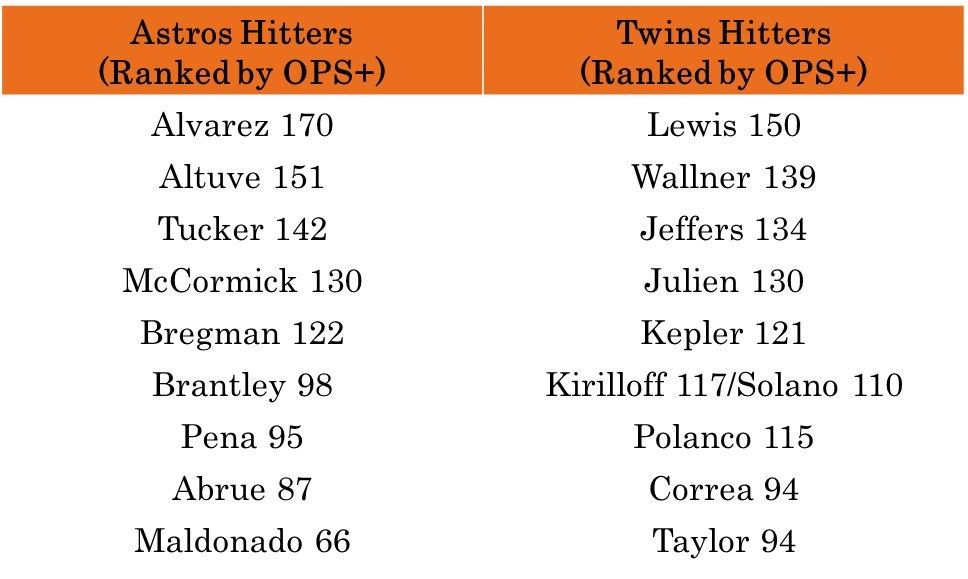Astros Bats and Twins Arms Square Off in an Evenly Matched Series: My ALDS Preview
The Astros have a better offense keyed by their big stars at the plate. The Twins keep runs off the board by striking out batters. This strength-on-strength matchup is key to winning the ALDS.
The Astros 5-1 road trip to end the season, combined with the Rangers managing to lose 3 of 4 in Seattle gave the Astros an unexpected playoff gift—a bye to the Division Series. I constantly make the point that the playoffs are a crapshoot and the bye means that the Astros get to endure one fewer set of dice rolls, avoiding the 3 game Wild Card Series.
The Minnesota Twins were not so lucky. Despite clinching their division much earlier than the Astros, they had a worse record and were the #3 seed in the playoffs, requiring them to play in a 3-game Wild Cart series against the Toronto Blue Jays.
No problem for the Twins, as they showed off their outstanding pitching staff. Twins hurlers held the Jays to 1 run in 18 innings. And while all individual game results are inherently surprising, these results were the least surprising possible. In the regular season, the Twins allowed the fewest runs of any American League playoff team.1
Those run prevention abilities should clue you in to something about the Twins—they are a better team than you think. The Twins seem to have been absent from the national baseball conversation this season due to 1) their lack of high level superstar play and 2) their somnambulant division, which they won easily thanks in large part to the fact that no other AL Central team had a record over .500.
The Twins are deeper than the Astros and have advantages in things like their 3rd and 4th starter and toward the bottom of their lineup. The Twins are a big power team—they hit a lot of home runs and strike out a lot of batters—but hit few singles and give up a lot of home runs.
The big matchup in this series is between Twins pitchers—who gave up the 4th fewest runs per game in baseball and had the highest strikeout rate—and Astro hitters—who scored the 5th most runs per game and were the third hardest set of batters to strike out. That is a classic strength-on-strength matchup and if the Astros hitters can make contact at the plate, they will have a big advantage.
As always, I will preview the series by looking at each team’s key offensive and defensive numbers (including fielding) across the season and discuss the lineups, rotations, and bullpens, ranking each by a broad metric of run creation (OPS+) or prevention (ERA+ for starters; FIP for relievers).
Such a method allows me to focus on the broader quality of the two teams. Then I discuss “what to watch for” in the series, which talks about the areas of the series where one team can exploit another’s weakness or where the strengths of the two teams will create a big inflection point in the series.
The Pitching
I start on the mound where the Twins have their biggest advantage. The chart below shows you the stats and major league ranks for both teams and it clearly shows that the Twins pitching is in the top tier in the majors in most of the categories listed here. And the Astros…are not. They are in the middle tier.
The Twins success on the mound centers on their ability to control the strike zone. They led the majors in strikeout rate but also had the fourth lowest walk rate in the majors. They are in the strike zone and get lots of whiffs. It leads to very low triple slash line numbers for their opponent. The average batter against the Twins slashes .236/.299/.398 for an OPS of .697. The batter closest to those numbers this season was Ezequiel Tovar who slashed .253/.287/.408 for an OPS for .695, and if you have a lineup of 9 Ezequiel Tovars, you’re not going to score a lot of runs.
Astros pitchers have been particularly vulnerable to walks and home runs. That is not the best formula. They do strike out a healthy number of batters and that helps keep opponents’ batting average low. But after a strong first two months of the season, the Astros pitching staff has regressed to the middle of the pack among MLB teams. They will be at a disadvantage in this series.
The Rotation
By 2023 ERA, the best pitcher in this series is Sonny Gray, which I think would surprise most observers. The Twins actually went with Pablo Lopez as their Game 1 starter in the Wild Card Series and Gray in Game 2, and both were excellent against the Blue Jays. Beyond that comes Bailey Ober, who is less heralded but quite effective in 2023. He’ll start Game 4. Joe Ryan—who had a disappointing season after a promising rookie year in 2022—is expected to start Game 1 though off days would allow Lopez to pitch Game 5 on regular rest.
Because they got a bye to this round, the Astros were able to align their pitching staff as they like, and they can put their two best starters—Justin Verlander and Framber Valdez as Games 1 and 2 starters respectively. Because of the ways the off days fall, the Astros could pitch both of these starters twice if the series goes 5 games, though that would require the Game 4 starter to go on short rest.
But that may be advantageous because the Astros options for a 3rd and 4th starter are not inspiring. Cristian Javier is likely to go in Game 3, but he has not pitched to his talent this season. The Game 4 options are JP France, whose ERA is much better than his peripherals suggest and Jose Urquidy, who made only 1 start in the last 7 weeks of the season. One can see why pushing one of Valdez or Verlander on short rest may be the call here.
The Bullpens
Each team has a candidate for the best reliever in the playoffs.2 For the Twins, it’s Jhoan Duran, who regularly throws 100 plus. For the Astros, it’s Bryan Abreu who features a wicked slider and the shoulders of a defensive end. Both teams want each to pitch key innings.
Overall, the Astros bullpen is slightly deeper though some of their top arms (Neris and Graveman in particular) have much better ERA than they do FIPs. The Twins lineup features a number of left handed batters in platoon (Julien, Kirilloff, Kepler) but the Astros lack the left handed bullpen arms to force the Twins to deploy their right handed bench bats.
Twins relied on these five arms out of the bullpen in their Wild Card series and they were very effective. Caleb Thielbar is their lefty arm and we will see him against the Yordan/Tucker pocket of the Astros order late in games. Louis Varland was moved to the bullpen late in the year and has been quite effective there.
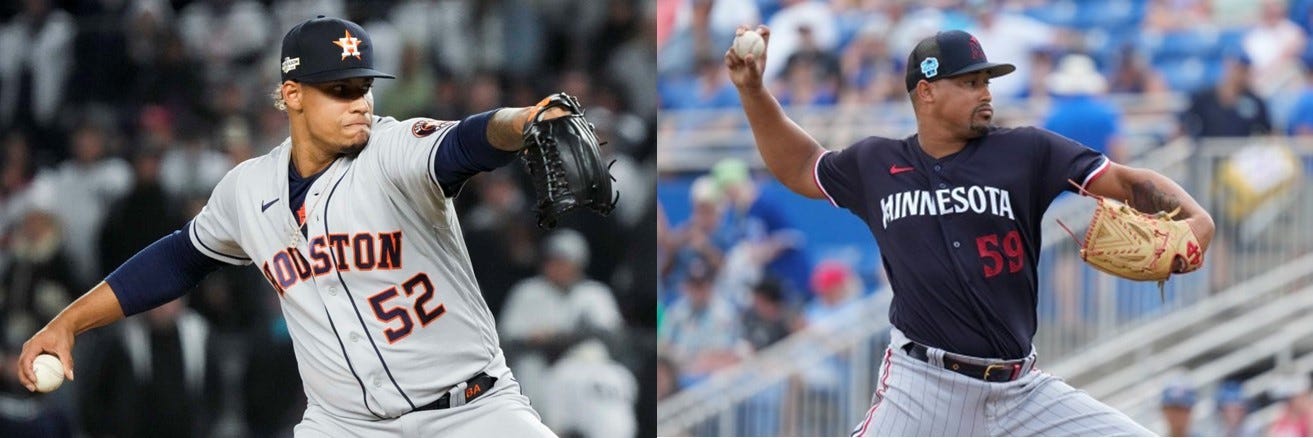
The Fielding
There is essentially no fielding advantage this series. As the chart below shows, some defensive measures prefer the Astros and some prefer the Twins. But the simplest measure of defense is defensive efficiency—which measures the share of balls into play turned into outs.3 Both teams turn 69.7% of balls hit into the field of play into outs.
For the Astros, this represents a decline from the outstanding defensive seasons the team put in from 2019 through 2022. The defensive step back is part of the team’s general decline in run prevention this season. The starters have shouldered most of the blame for that but the fielders have contributed as well.
The Twins are a steady defensive team. They have few outstanding defenders but few poor ones. Center fielder Michael A. Taylor is their best defender, but at 5 Defensive Runs Saved, he’s not a Gold Glove candidate. First baseman Alex Kirilloff is their worst at -8 DRS. As befitting a steady defensive team, the Twins make few errors.
The Hitting
The Astros started the season in a big slump and rallied over the season’s last four months to become one of the best offensive teams in baseball. In fact, over the last two months of the season, the Astros had a wRC+ of 130, which is not only 30% better than league average, it is just decimal points behind the Braves for the best offense in baseball. But 3rd on that list is the Twins, who had a wRC+ of 125.4 In short, both offenses got better throughout the season.
But overall, the Astros offense is stronger than that of the Twins. In particular, the Astros hit more singles—917 to 814—which leads to a higher batting average. That allowed the Astros to have a higher on base percentage than the Twins, despite the Twins superior walk rate.
The Twins big advantage is in power. They hit 233 home runs this season, which pushed their slugging percentage up close to the Astros. The Astros pitching staff is vulnerable to homers and this is the biggest concern in that matchup between Astros arms and Twins bats.
The Astros avoid being struck out, finishing with the third lowest strikeout rate in the majors. It is a big contrast to the Twins bats, who strike out more than any other team in baseball. This is the Astros clearest advantage in these numbers.
The Lineups
The top three guys in the Astros lineup are better than the top three guys in the Twins lineup. Yordan Alvarez is a better hitter than the Twins top hitter Royce Lewis. Jose Altuve is better than Matt Wallner and Kyle Tucker is better than Ryan Jeffers. The Astros advantage is among their best hitters.
But go down the table above, which is sorted by OPS+, to the last three batters and you will see that the Twins bottom three hitters are better than the Astros bottom three hitters. Jorge Polanco is better than Jeremy Pena. Carlos Correa is better than Jose Abreu and Michael A. Taylor is significantly better than Martin Maldonado.
The teams are pretty even in the middle, so the question becomes which advantage—the Astros among the stars—or the Twins among the scrubs—plays out as most important over the five games of the series.
Keys to the Series
Can the Twins pitchers strike out Astros hitters? The Twins led the majors in striking out opposing batters. The Astros were the third hardest team to strike out this season. As noted, the Astros have an advantage over the Twins in batting average and hitting singles, and a good part of that stems from the fact that they put more balls into play than their opponents. But if the Twins pitchers dominate Astros hitters, that advantage goes away.
Will the Astros get star level production from their offensive stars? The Astros have the best two hitters in the series in Yordan Alvarez and Jose Altuve and much of their offensive advantage stems from those two hitters. The Astros need big production from both the Big Man and the Little Giant to outscore the Twins and defeat their excellent pitching staff.
Will the Twins depth guys in their lineup produce? The Twins biggest advantage in this series is that their lineup is deeper than the Astros. They got better production through the season from hitters such as Jorge Polanco and Carlos Correa than the Astros got from Jeremy Pena and Jose Abreu. If that continues over the next five games, advantage Twins.
How quickly will Dusty go to his bullpen? In the 2020 and 2021 playoffs, Dusty Baker had a quick hook in the playoffs for his starting pitchers. In the 2022 playoffs, he was willing to let his starters go longer, even when they were struggling. Those decisions were undoubtedly made based on Dusty’s evaluation that his starting staff was wobbly in ‘20 & ‘21 and stronger in ‘22. How he evaluate his rotation this year is thus a key question. We may see something of a in-between approach. Verlander and Valdez get to go close to 100 pitches, but Dusty has a quick hook for his Game 3 and 4 starters, who were wobbly this season and should never see the third time through the order.
Concluding Thoughts
These two teams are relatively evenly matched. The Astros have a better offense and the Twins have a better pitching staff. In that sense, it’s a classic strength against strength matchup. The Twins are a deeper team than the Astros but the Astros have the top handful of players in the series. Both teams have effective bullpens.
As such, there is every reason to think the ALDS will be close. Of course, it is short series baseball, so there is every reason to think that any outcome is possible. The playoffs, as I constantly remind Astros fans at this time of the year, are a crapshoot and any advantage—the Astros bats or the Twins arms—is modest over five games.
The good news for Astros fans is that the computers think they have a bigger advantage than I do. The Fangraphs Depth Charts projection says they have a 57.3% chance of winning over the Twins. And that’s the lowest set of odds. The Pecota projection at Baseball Prospectus says they have a 59.7% chance of winning, and the ZiPS projection system gives the Astros a 63.6% chance of winning the series.
Regardless, the lesson here is that the advantages in short series baseball are modest. The Astros were not the dominant regular season team we have seen in recent seasons, but in many ways that matters little. They are in a crapshoot now and we need the dice to come up our way. And history tells us they tend to do that.
Here’s to the Playoffs.
The Mariners actually allowed fewer, which helped push them toward the .540 winning percentage that their Jerry DiPoto aspires to.
Felix Bautista would win this but he needs Tommy John Surgery. Pour one out for Felix.
Thus it excludes home runs, walks, and strikeouts.
Both of these number come from the Joe Sheehan Newsletter from October 2. Sheehan’s is a paid newsletter and is highly recommended for all baseball fans.




